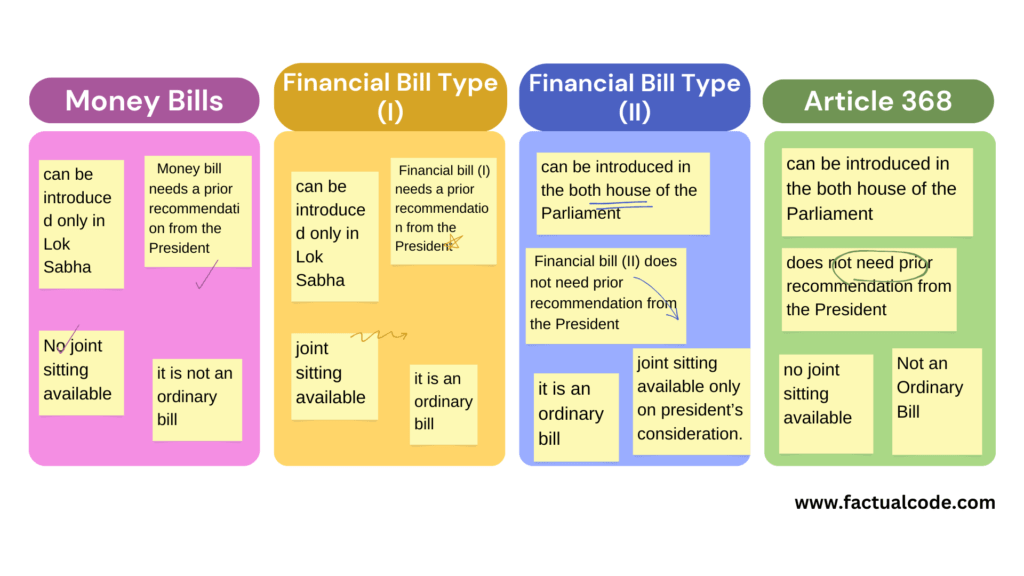
India, as a democratic republic, operates under a parliamentary system where laws are formulated, debated, and passed by the Parliament. This article simplifies and elaborates on how laws are made in India, aiming to make the process easier to understand.
1. Introduction to the Indian Legislative Process
The legislative process in India follows a structured path from proposal to enactment. Any law in India is called an “Act of Parliament“ when both Houses of Parliament pass it and receive the President’s assent.
The Parliament
The Parliament of India is the supreme legislative authority and consists of two Houses:
- Lok Sabha (House of the People): Members are directly elected by the public.
- Rajya Sabha (Council of States): Members are indirectly elected by state legislatures.
Types of Bills
There are several types of bills that can be introduced in Parliament:
- Ordinary Bills: Relating to any matter except money or constitutional amendments.
- Money Bills: Bills that exclusively deal with taxation, borrowing, or expenditure.
- Financial Bills: Bills dealing with financial matters, but not purely money bills.
- Constitutional Amendment Bills: These are for amending the Constitution of India.
2. Stages in the Passing of a Bill
(a) Introduction (First Reading)
- A Bill can be introduced by either a Minister (Government Bill) or a Private Member (Private Member Bill).
- In Lok Sabha or Rajya Sabha, the Bill is read out, and the House grants permission to introduce it.
(b) Second Reading (Consideration Stage)
- Clause-by-Clause Examination: The Bill is discussed in detail.
- Amendments to the Bill may be proposed and voted on by the members.
- The Select Committee or Standing Committee can be referred to if further examination is required.
(c) Third Reading (Final Vote)
- The Bill is debated and voted on after the amendments have been made.
- If it passes in one House, it is then sent to the other House for consideration.
3. Role of the President
- Once both Houses have passed the Bill, it is sent to the President of India.
- The President can either give assent, withhold assent, or return the Bill with recommendations.
- If the Bill is returned and passed again by both Houses, the President must give assent.
4. Special Procedures for Money Bills
- Money Bills are introduced only in Lok Sabha.
- After passing the Lok Sabha, the Bill is sent to Rajya Sabha, which can suggest recommendations but cannot reject the Bill.
- Rajya Sabha must return the Bill within 14 days. If no action is taken, it is considered passed.
Examples of Money Bills:
- Finance Act: Deals with the annual budget.
- Appropriation Bill: Relates to withdrawals from the Consolidated Fund of India.
5. Joint Sitting of Both Houses
- In case of a deadlock, where one House disagrees with the other, the President can call a joint sitting of both Houses to resolve the deadlock.
- The decision of the majority is considered final.
6. Constitutional Amendments
- Unlike Ordinary and Money Bills, Constitutional Amendments require a special majority (two-thirds of members present and voting) in both Houses.
- Certain amendments affecting federal structure also need ratification by at least half of the state legislatures.
Recent Examples of Constitutional Amendments:
- Goods and Services Tax (GST): A significant overhaul of India’s indirect tax system.
- Right to Education Act: Made education a fundamental right for children.
7. Conclusion
The process of making laws in India is both detailed and rigorous to ensure democratic values are upheld. From the initial proposal to Presidential assent, every step is designed to allow thorough scrutiny, debate, and discussion, ensuring that laws are fair, just, and in alignment with the Indian Constitution.
📖 Recommended Reading
For a deeper dive into the structure and principles of the Indian Constitution, we recommend reading our in-depth article, “India’s Constitution Decoded: A Total Insight”. This guide offers comprehensive insights into India's Constitution, helping you understand its fundamental rights, duties, and the overall legal framework of the country.
📚 Recommended Reading
If you're interested in the cross-references between the Bharatiya Nyaya Sanhita (BNS) 2023 and the Indian Penal Code (IPC), check out:
- 📌 IPC to BNS: Cross-Reference Section Index of Bharatiya Nyaya Sanhita 2023 (BNS) and Indian Penal Code (IPC) - This guide provides a section-by-section comparison to help readers understand the transitions and updates between the IPC and BNS.
📚 Featured Article
Discover the fascinating journey of legal systems from ancient times to the present day:
- 📌 From Ancient Codes to Modern Justice: A Journey Through the Evolution of Law - Explore the origins and evolution of legal principles that have shaped modern justice systems around the world.
References- sansad.in sansad.in sansad.in unacademy.com byjus.com www.business-standard.com nextias.com byjus.com en.wikipedia.org taxo.online THE APPROPRIATION BILL, 2024 byjus.com www.nextias.com www.investopedia.com THE RIGHT OF CHILDREN TO FREE AND COMPULSORY EDUCATION ACT, 2009 THE CONSTITUTION OF INDIA

